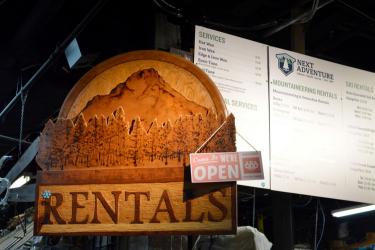
In March of 2015, I stood in the gravel parking lot of the Grave Creek Boat Ramp along the Rogue River. Brightly colored rafts were tethered to various spots on the bank as guides and clients ferried gear and supplies from vehicles to their respective vessel. What were these people doing and how were they going to experience the Wild and Scenic Rogue River differently than I? I tightened the laces on my boots, shouldered my pack and questions and hit the trail.
My questions were answered 11.5 miles later at Half Moon Bay. My sore feet stumbled down the slippery trail to the riverside camping area. I pitched my tent in the pouring rain. Under the meager rainfly on my barely-a-two-person tent, I cooked my day’s ration of quinoa, and I shivered. I stumbled down to the river’s edge to filter water and to my amazement I found one of those brightly colored rafts moored in an eddy. Upriver from the raft, and my sorry predicament, the crew of the raft was sitting around a firepan with a roaring fire. I waved, and they waved back with a beckoning gesture. They had a tarp shelter. They had a roaring fire. They had a huge pot of chili stewing over a two-burner stove. And most importantly they had a cooler brim full of beer. I must have looked as I felt, because the two rafters, as I came to learn their lingo, immediately offered all of the creature comforts I had sworn off at the trailhead 11.5 miles back. The rest of the 40-mile trip I questioned my hobby and my past-time of backpacking. I needed to become a rafter.

One would think I learned my lesson, however, on that same beach a year and a half later I found myself feeling the exact same feels: sore feet, sore shoulders, an empty stomach that couldn’t be filled with my meager rations, and absolute envy of Half Moon Bay’s rafting population. A change needed to be made.
Two months ago, my wife floated the idea of hiking a section of the Pacific Crest Trail in northern Oregon. My mind got to work. We needed light gear, the lighter the better. How many calories could we survive on without losing too much weight? Could we crush eighteen miles a day to reach our destination? Will my training shoes last through the actual hike? How much do pockets on a pair of shorts weigh? We could save weight on clothes by hiking naked. But then we’d need to carry more bug spra—WAIT! My mind immediately floated back to roaring fires, coolers of beer, unlimited chili, and experience the same backcountry that I have come to love and yearn for, without all of the suffering.
I’m not a paddler, I’m not a boater, and I’m certainly not a rafter. After pouring over guide reviews, Instagram pictures of wild rivers, and googling, “how to become a rafter”, my first stop was the Next Adventure Paddle Sports Center. I needed answers to questions that I hadn’t yet formulated. I saddled up to the counter with the hesitancy that came from years of not being the cool kid, and these guys were so cool. With a big smile and a Midwestern accent, an associate asked what water sport I was shopping for. My heart raced. I muttered, “I want to learn to raft.”
“
yes!” was the hook I needed.
I was soon to learn that with every season comes a different demand in personal gear, but the basics were as such: a life jacket, protection from the water temperature, protection for the head, and footwear with modesty garments thrown in for modesty’s sake.
I chose the Astral YTV PFD, a used wetsuit, the Sweet Protection Rocker Helmet, and my personal Chaco sandals. I wasn’t pushed to completely overhaul my gear room and Mr. Midwest encouraged that I recycle as much of my own gear as possible. I am going to be a rafter.
My first trip is next week. Stay tuned…

 In March of 2015, I stood in the gravel parking lot of the Grave Creek Boat Ramp along the Rogue River. Brightly colored rafts were tethered to various spots on the bank as guides and clients ferried gear and supplies from vehicles to their respective vessel. What were these people doing and how were they going to experience the Wild and Scenic Rogue River differently than I? I tightened the laces on my boots, shouldered my pack and questions and hit the trail.
My questions were answered 11.5 miles later at Half Moon Bay. My sore feet stumbled down the slippery trail to the riverside camping area. I pitched my tent in the pouring rain. Under the meager rainfly on my barely-a-two-person tent, I cooked my day’s ration of quinoa, and I shivered. I stumbled down to the river’s edge to filter water and to my amazement I found one of those brightly colored rafts moored in an eddy. Upriver from the raft, and my sorry predicament, the crew of the raft was sitting around a firepan with a roaring fire. I waved, and they waved back with a beckoning gesture. They had a tarp shelter. They had a roaring fire. They had a huge pot of chili stewing over a two-burner stove. And most importantly they had a cooler brim full of beer. I must have looked as I felt, because the two rafters, as I came to learn their lingo, immediately offered all of the creature comforts I had sworn off at the trailhead 11.5 miles back. The rest of the 40-mile trip I questioned my hobby and my past-time of backpacking. I needed to become a rafter.
In March of 2015, I stood in the gravel parking lot of the Grave Creek Boat Ramp along the Rogue River. Brightly colored rafts were tethered to various spots on the bank as guides and clients ferried gear and supplies from vehicles to their respective vessel. What were these people doing and how were they going to experience the Wild and Scenic Rogue River differently than I? I tightened the laces on my boots, shouldered my pack and questions and hit the trail.
My questions were answered 11.5 miles later at Half Moon Bay. My sore feet stumbled down the slippery trail to the riverside camping area. I pitched my tent in the pouring rain. Under the meager rainfly on my barely-a-two-person tent, I cooked my day’s ration of quinoa, and I shivered. I stumbled down to the river’s edge to filter water and to my amazement I found one of those brightly colored rafts moored in an eddy. Upriver from the raft, and my sorry predicament, the crew of the raft was sitting around a firepan with a roaring fire. I waved, and they waved back with a beckoning gesture. They had a tarp shelter. They had a roaring fire. They had a huge pot of chili stewing over a two-burner stove. And most importantly they had a cooler brim full of beer. I must have looked as I felt, because the two rafters, as I came to learn their lingo, immediately offered all of the creature comforts I had sworn off at the trailhead 11.5 miles back. The rest of the 40-mile trip I questioned my hobby and my past-time of backpacking. I needed to become a rafter.
 One would think I learned my lesson, however, on that same beach a year and a half later I found myself feeling the exact same feels: sore feet, sore shoulders, an empty stomach that couldn’t be filled with my meager rations, and absolute envy of Half Moon Bay’s rafting population. A change needed to be made.
Two months ago, my wife floated the idea of hiking a section of the Pacific Crest Trail in northern Oregon. My mind got to work. We needed light gear, the lighter the better. How many calories could we survive on without losing too much weight? Could we crush eighteen miles a day to reach our destination? Will my training shoes last through the actual hike? How much do pockets on a pair of shorts weigh? We could save weight on clothes by hiking naked. But then we’d need to carry more bug spra—WAIT! My mind immediately floated back to roaring fires, coolers of beer, unlimited chili, and experience the same backcountry that I have come to love and yearn for, without all of the suffering.
I’m not a paddler, I’m not a boater, and I’m certainly not a rafter. After pouring over guide reviews, Instagram pictures of wild rivers, and googling, “how to become a rafter”, my first stop was the Next Adventure Paddle Sports Center. I needed answers to questions that I hadn’t yet formulated. I saddled up to the counter with the hesitancy that came from years of not being the cool kid, and these guys were so cool. With a big smile and a Midwestern accent, an associate asked what water sport I was shopping for. My heart raced. I muttered, “I want to learn to raft.”
“
One would think I learned my lesson, however, on that same beach a year and a half later I found myself feeling the exact same feels: sore feet, sore shoulders, an empty stomach that couldn’t be filled with my meager rations, and absolute envy of Half Moon Bay’s rafting population. A change needed to be made.
Two months ago, my wife floated the idea of hiking a section of the Pacific Crest Trail in northern Oregon. My mind got to work. We needed light gear, the lighter the better. How many calories could we survive on without losing too much weight? Could we crush eighteen miles a day to reach our destination? Will my training shoes last through the actual hike? How much do pockets on a pair of shorts weigh? We could save weight on clothes by hiking naked. But then we’d need to carry more bug spra—WAIT! My mind immediately floated back to roaring fires, coolers of beer, unlimited chili, and experience the same backcountry that I have come to love and yearn for, without all of the suffering.
I’m not a paddler, I’m not a boater, and I’m certainly not a rafter. After pouring over guide reviews, Instagram pictures of wild rivers, and googling, “how to become a rafter”, my first stop was the Next Adventure Paddle Sports Center. I needed answers to questions that I hadn’t yet formulated. I saddled up to the counter with the hesitancy that came from years of not being the cool kid, and these guys were so cool. With a big smile and a Midwestern accent, an associate asked what water sport I was shopping for. My heart raced. I muttered, “I want to learn to raft.”
“
